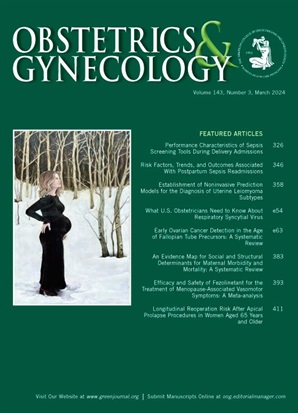人工智能辅助阴道镜检查在资源有限人群中的有效性。
IF 4.7
2区 医学
Q1 OBSTETRICS & GYNECOLOGY
引用次数: 0
摘要
目的评价人工智能阴道镜在资源有限地区检测宫颈癌和癌前病变的性能。方法本研究为横断面研究。人乳头瘤病毒阳性或细胞学阳性的参与者被转诊进行阴道镜检查,在此期间实施人工智能阴道镜检查。对阴道镜检查人员或人工智能系统提示的阳性结果进行活检。为了进行分析,我们计算了宫颈上皮内瘤变(CIN) 2+和CIN 3+的敏感性、特异性、阳性预测值、阴性预测值和曲线下面积。组织病理学是疾病诊断的金标准。结果825例女性行阴道镜检查,其中CIN 2+ 99例(12.0%),CIN 3+ 53例(6.4%)。常规阴道镜检查阳性392例(47.5%),人工阴道镜检查阳性640例(77.6%)。人工智能阴道镜和人工智能辅助阴道镜检测CIN 2+的灵敏度(96.0%)明显高于常规阴道镜(85.9%,P=。026, P <。001年,分别)。绝经后妇女人工智能阴道镜检查(94.3%)和人工智能辅助阴道镜检查(100%)的敏感性高于常规阴道镜检查(77.4%,P=。026, P <。001年,分别)。人工智能辅助阴道镜也显著提高了临床经验不足10年的初级阴道镜检查人员的灵敏度,达到100%,而传统阴道镜检查的灵敏度为84.6% (P= 0.001),并且提高了对未见鳞柱交界处的女性的检出率(100%对70.4%,P= 0.004)。对于CIN 3+,人工智能辅助阴道镜的敏感性优于常规阴道镜(100% vs 86.8%, P= 0.013)。绝经后妇女人工智能阴道镜和人工智能辅助阴道镜的敏感性均为100%;而传统阴道镜检查的敏感性为77.8% (P= 0.023)。结论人工智能辅助阴道镜检查可提高CIN 2+和CIN 3+的检测灵敏度,尤其是绝经后妇女。此外,它提高了初级阴道镜医生的诊断性能,并提高了对不可见的鳞状柱连接处的妇女的检测。本文章由计算机程序翻译,如有差异,请以英文原文为准。
Effectiveness of Artificial Intelligence-Assisted Colposcopy in a Resource-Limited Population.
OBJECTIVE
This study evaluates the performance of artificial intelligence (AI) colposcopy in detecting cervical cancer and precancerous lesions in real-world scenarios within resource-limited areas.
METHODS
This is a cross-sectional study. Participants with positive human papilloma virus results or who were cytologic positive were referred for colposcopy, during which AI colposcopy was implemented. Biopsies were performed for positive findings suggested by either the colposcopist or the AI system. For the analysis, we calculated the sensitivity, specificity, positive predictive value, negative predictive value, and area under the curve for detecting cervical intraepithelial neoplasia (CIN) 2+ and CIN 3+. Histopathology was the gold standard for disease diagnosis.
RESULTS
A total of 825 women underwent colposcopy, with 99 (12.0%) diagnosed with CIN 2+ and 53 (6.4%) with CIN 3+. Positive findings were reported in 392 women (47.5%) under conventional colposcopy and 640 (77.6%) with AI colposcopy. The sensitivity for detecting CIN 2+ was significantly higher for AI colposcopy (96.0%) and AI-assisted colposcopy (100%) than for conventional colposcopy (85.9%, P=.026, P<.001, respectively). In postmenopausal women, the sensitivities of AI colposcopy (94.3%) and AI-assisted colposcopy (100%) surpassed that of conventional colposcopy (77.4%, P=.026, P<.001, respectively). Artificial intelligence-assisted colposcopy also significantly enhanced the sensitivity of junior colposcopists with less than 10 years of clinical experience, achieving 100% compared with 84.6% by conventional colposcopy (P=.001), and improved detection in women with a squamocolumnar junction that was not visible (100% vs 70.4%, P=.004). For CIN 3+, the sensitivity of AI-assisted colposcopy was superior to that of conventional colposcopy (100% vs 86.8%, P=.013). In postmenopausal women, the sensitivities of both AI colposcopy and AI-assisted colposcopy were 100%; however, the sensitivity of conventional colposcopy was 77.8% (P=.023).
CONCLUSION
Artificial intelligence-assisted colposcopy enhances sensitivity in detecting CIN 2+ and CIN 3+, particularly among postmenopausal women. Moreover, it improves the diagnostic performance of junior colposcopists and improves detection in women with a squamocolumnar junction that is not visible.
求助全文
通过发布文献求助,成功后即可免费获取论文全文。
去求助
来源期刊

Obstetrics and gynecology
医学-妇产科学
CiteScore
11.10
自引率
4.20%
发文量
867
审稿时长
1 months
期刊介绍:
"Obstetrics & Gynecology," affectionately known as "The Green Journal," is the official publication of the American College of Obstetricians and Gynecologists (ACOG). Since its inception in 1953, the journal has been dedicated to advancing the clinical practice of obstetrics and gynecology, as well as related fields. The journal's mission is to promote excellence in these areas by publishing a diverse range of articles that cover translational and clinical topics.
"Obstetrics & Gynecology" provides a platform for the dissemination of evidence-based research, clinical guidelines, and expert opinions that are essential for the continuous improvement of women's health care. The journal's content is designed to inform and educate obstetricians, gynecologists, and other healthcare professionals, ensuring that they stay abreast of the latest developments and best practices in their field.
 求助内容:
求助内容: 应助结果提醒方式:
应助结果提醒方式:


